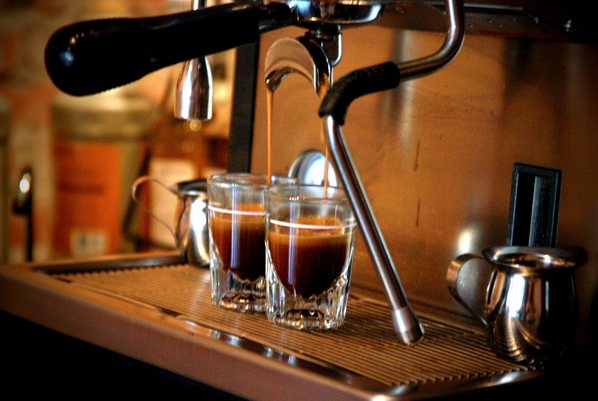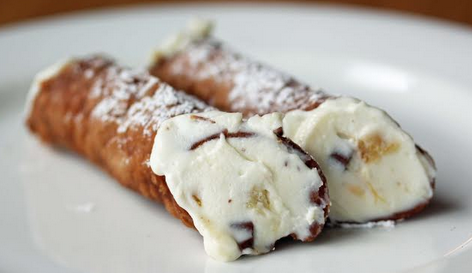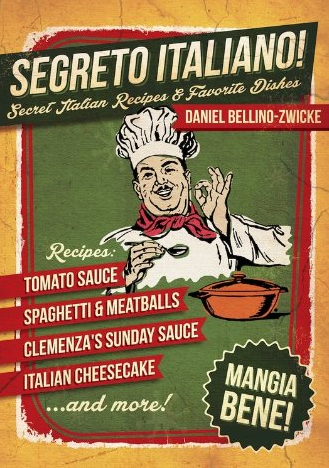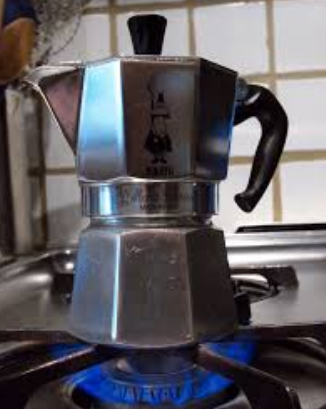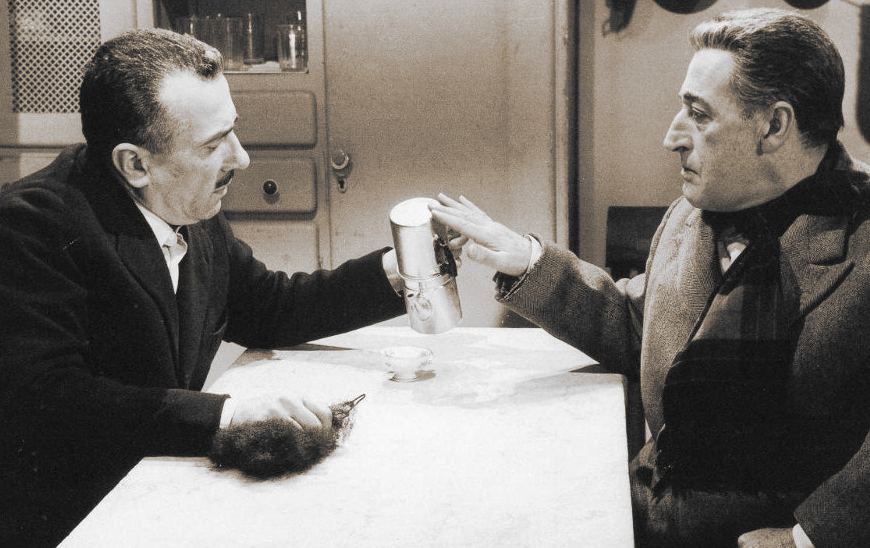ESPRESSO
Espresso,
the making, consuming and enjoyment of a properly made Espresso is another
facet and time honored tradition of Italian-Americans and their culture. We do
love our properly pulled Espresso. A properly pulled Espresso is a thing of
beauty and refinement, and must be done just so. We can and do make Espresso in
our homes with either a Neapolitan or Moka brewing device, and now these days, there
are any number of expensive new-fangled home espresso makers, more on that
later.
Some
might be surprised but the great art of the perfect Italian Espresso has been
around for just about 110 years. Yes Italians drank Espresso before that, but
it was only developed into a “Fine Art” that it is today, just a little more
then a hundred years ago or so when Luigi Bezzera developed the first Espresso
Machine that we know today. After this landmark in Espresso history, the
consumption and popularity of Espresso grew rapidly. Caffes and Espresso Bars
popped up everywhere all over Italy. These Espresso Bars were places to have an
Espresso and socialize. And in Italy, there is a whole act and ritual to going
to an Espresso Bar for your habitual morning coffee. And it’s not just for the
Espresso but some socializing, a bit of chit-chat, gossip, political talk,
sports (Soccer/Futbol), this-that-and-every-other-thing. This morning Espresso
is quite ritualistic in Italy, and is practiced by most, and in every corner of
the country, on every other street corner in cities like; Rome, Bologna, Palermo,
Milano, Verona, all over. And it is quite the sight to see, especially if
you’re an American going for the first time. In caffes and bars in Italy it is
at the stand-up Espresso bar where all the action takes place. When you go into
a caffe (a.k.a. Bar) in Italy and have a Espresso, Cappuccino, whatever, and
sit at a table, that Espresso will cost you an additional 50% or more than it
will if you consume it standing up at the counter at the Espresso Bar. It’s a
tax thing. The caffe owners are taxed on their tables and this tax gets passed
on to the customer. Basta!
Anyway, the ritual of the early morning Italian Espresso? People get dressed, leave
their homes and are on their way to work, but they don’t go right from their
house to their job. No they have to have an Espresso and the ritual of the
Espresso and some Chit-Chat (BS) with a quick stop at their favorite local
caffe. They might leave their house then go to an Espresso Bar near their home
before going to their job, or they may head to their job, then get an Espresso
at a favored caffe near the work-place. They might even do both, get an
Espresso in their neighborhood before heading to work, then stopping at
an Espresso Bar close to their workplace before bopping into work.
Well, that’s the way they do it in Italy, quite a ritual and amazing to see.
In America, Italian immigrants to cities like New York, Boston, Providence,
and Philadelphia opened Social Clubs that served Espresso, maybe some
sandwiches, soup, soda, Biscotti, and Anisette Toast, and Cannoli that
they bought from a nearby baker. These Social Clubs which sprung up in
neighborhoods like the Lower East Side of New York or what
is now called Little Italy, in Boston’s North End, and San Francisco’s North
Beach. These Social Clubs (Caffe) were primarily of and for the working class,
and were for Italians. The clubs were for Italians, and people of other
nationalities did not go into them unless they were brought in by an Italian
guy from the neighborhood. And that’s the way it was back then.

Espresso
e Dolce at home? When I was growing up and went to my Aunt Fran and Uncle
Tony’s house in Lodi, or to Aunt Helen’s for Sunday Dinner, and we ate our
meal, and it moved on to coffee and dessert, this was quite a sight that brings
back nice memories for me to this very day. And it was a wonderful ritual, and
unlike the quick grab your Espresso, Chit-Chat for a few minutes and run out
the door as is done at caffe’s and Espresso Bars in Italy, the Espresso was
anything but Espresso (Fast) at Bellino Family meals, as is with millions of
Italian-American families over the years. No, this was no quick hit-and-run
affair. The coffee and dessert course at our family gatherings was the longest
portion of our all day affair of the Sunday Meal. My Aunts and Uncles would sit
around the table, we (the Kids) would too, but we would go back and forth,
cause this sit-down at the table usually lasted about 3 hours, maybe more. We’d
sit down, and Aunt Fran and Aunt Helen had the Neapolitan going with Espresso.
The table was laden with all sorts of goodies; Cannolis of course, one or two
different cakes, and an assortment of Italian Cookies and Pastries
(Sfogiatelle, Mille Foglie). There was always enough to fill Pastry Shop
Showcase, “I kid you not!”
The table full of my aunts and uncles was a wonder. They’d sit around drinking
coffee, eating pastries, and talk-talk-talk, about politics, sports, gossip,
this-that-and-everything. My uncle Frank who was the Ring-Leader could have
solved all the Worlds problems, right there at that table, filled with Cannoli,
Biscotti, Coffee (Espresso), cakes, Anisette, heated discussion, laughter, and
a “Bundle of Joy,” all over Espresso.
Aunt Helen and Aunt Fran made the Espresso in Neapolitan Espresso Maker.
The Neapolitan is from Napoli, Italy. It was developed so Neapolitans (and all
Italians) could make Espresso in their homes. The Neapolitan is a two-piece
device whereby, you fill the bottom of the vessel with water, the ground
espresso goes in the middle and you screw on the empty top. To make Espresso
with the Neapolitan you put the device on the stove over a flame with the piece
filled with the water on the stove. The water heats, and when it comes to the
boil, you turn the flame off, flip the vessel over so the hot water is at the
top and will then drip down through the ground coffee to make the Espresso.
The Espresso is not as good as that you’d get at a caffe or Espresso Bar with a
large machine, but it’s good enough, and adding a little shot of Anisette is
never a bad thing, something my Uncle Frank always did. This is called a Caffe
Corretto, the act of adding a few drops of your desire liquor into your
espresso. You can add; Grappa, Sambucca, Brandy, Anisette, or other liquor to
make a caffe corretto. At Aunt Fran & Unlce Tony’s, it was always Anisette.
Basta.
My NAPOLITAN
I Bought in NAPOLI 1987
As a child it was always something to see, watching Aunt Fran or Aunt Helen go
through the pleasant little ritual of making Espresso in that curious looking
contraption, the Neapolitan. As I said, it always intrigued me, and when I took
my first trip to Italy and was in Napoli walking through a street market and
spotted a merchant selling Neapolitans and other kitchenware’s, I just
had to get myself one, a Neapolitan of my own and from the great city
it was invented in, Napoli. I also brought back some beautiful ceramic
plates from nearby Vietro sul Mare on the nearby Amalfi Coast, and
I’ve been making Espresso with my Neapolitan (bought in Napoli), and
eating Spaghetti on those beautiful Amalfi Coast Plates from ever since, a joy,
and a way to bring Italy into your own American home. Doing so, brings back
beautiful memories of; Positano, The Amalfi Coast, Sicily, and the rest of
Italy. If you can’t be there (which is a shame), then bring Italy into your
home. And that is what we do, every time we sit down to a meal, a glass
of wine, or a simple little cup of Espresso, “we bring Italy home.”
ESPRESSO is Excerpted from Daniel Bellino-Zwicke 's SUNDAY SAUCE
SUNDAY SAUCE - When Italian-Americans Cook is Available in Paperback & Kindle
on Amazon.com
Cannolis Were Always on The Table
And a Bottle of Anisette
SECRET ITALIAN RECIPES
A MOKA POT
For Making Espresso
Toto & Peppino
with a NAPOLITAN
in
The BAND of HONEST MEN 1956
by DANIEL BELLINO-ZWICKE







